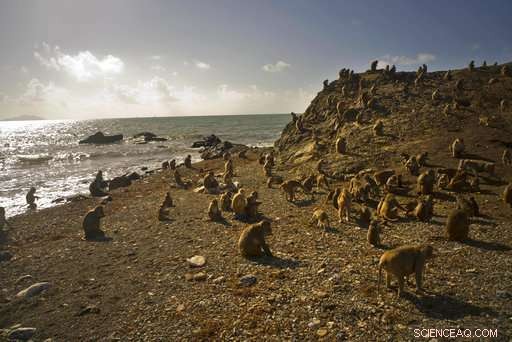
In questo mercoledì, 4 ottobre foto 2017, scimmie si muovono su Cayo Santiago, conosciuta come l'isola delle scimmie, a Porto Rico. Uno dei primi luoghi colpiti dall'uragano Maria nel territorio degli Stati Uniti il 20 settembre è stata Monkey Island, un affioramento di 40 acri al largo della costa orientale che è uno dei siti più importanti al mondo per la ricerca sul modo di pensare dei primati, socializzare ed evolvere. (Foto AP/Ramon Espinosa)
Mentre migliaia di soldati e impiegati governativi lottano per riportare la vita normale a Porto Rico, un piccolo gruppo di scienziati sta correndo per salvarne più di 1, 000 scimmie il cui cervello può contenere indizi sui misteri della mente umana.
Uno dei primi luoghi colpiti dall'uragano Maria nel territorio degli Stati Uniti il 20 settembre è stato Cayo Santiago, conosciuta come l'isola delle scimmie, un affioramento di 40 acri al largo della costa orientale che è uno dei siti più importanti al mondo per la ricerca sul modo di pensare dei primati, socializzare ed evolvere.
La tempesta ha distrutto praticamente tutto sull'isola, spogliandolo della vegetazione, distruggendo gli abbeveratoi metallici delle scimmie e schiacciando i moli che i lavoratori dell'Università di Porto Rico usano per portare i sacchetti di mangime per scimmie, pellet marroni di cibo lavorato che completano la dieta vegetale naturale dei primati.
"Tutti i nostri strumenti sono stati distrutti, " ha detto Angelina Ruiz Lambides, il direttore della struttura di Cayo Santiago. "La FEMA copre questo? L'assicurazione dell'università copre questo? Non lo so."
Incredibilmente, per quanto gli scienziati possono dire finora, le scimmie sono sopravvissute al colpo diretto dell'uragano, forse cercando un'altura e raggruppandosi alla base degli alberi.
Non sono stati trovati corpi e un censimento non rileva un gran numero di macachi scomparsi.
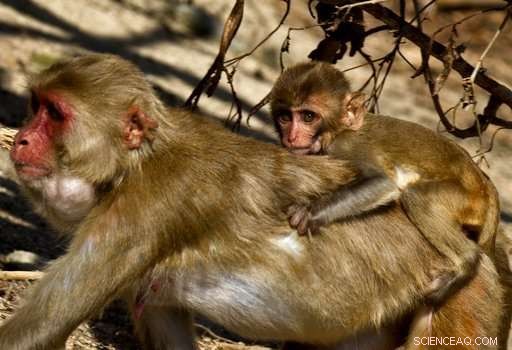
In questo mercoledì, 4 ottobre foto 2017, una scimmia porta il suo bambino sulla schiena a Cayo Santiago, conosciuta come l'isola delle scimmie, a Porto Rico, uno dei siti più importanti al mondo per la ricerca su come pensano i primati, socializzare ed evolvere. Ogni animale nato sull'isola è tatuato per una facile identificazione, e lo scheletro di tutti coloro che sono morti nel corso di nove generazioni è stato salvato per riferimento futuro. (Foto AP/Ramon Espinosa)
La storia dell'isola come centro di ricerca risale al 1938, quando l'uomo noto come il padre della scienza dei primati americani portò una popolazione di macachi rhesus indiani negli Stati Uniti. Clarence Ray Carpenter voleva un posto con il perfetto mix di isolamento e ruspante, dove le scimmie potrebbero essere studiate vivendo proprio come fanno in natura senza le difficoltà di rintracciarle in natura.
Da allora i circa 400 macachi hanno riprodotto e ampliato il loro numero, diventando la popolazione di primati ruspanti più studiata al mondo e una sorta di biblioteca vivente.
Ogni animale nato sull'isola è tatuato per una facile identificazione, e lo scheletro di tutti coloro che sono morti nel corso di nove generazioni è stato salvato per riferimento futuro. Circa 100 hanno avuto il loro intero corredo genetico sequenziato, e altre centinaia hanno analizzato almeno una parte del loro DNA.
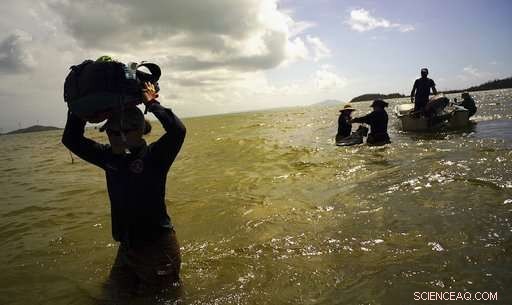
In questa schermata presa dal video di mercoledì, 4 ottobre 2017, gli scienziati tornano a terra da Cayo Santiago, conosciuta come l'isola delle scimmie, a Porto Rico, uno dei siti più importanti al mondo per la ricerca su come pensano i primati, socializzare ed evolvere. Dopo il passaggio dell'uragano Maria, lo staff dell'università e i dipendenti locali che tengono in funzione Monkey Island trasportano freneticamente sacchi di cibo in una piccola barca, alimentando i macachi con una dieta di sopravvivenza e cercando di rimontare i collettori dell'acqua piovana e gli abbeveratoi che mantengono in vita gli animali sotto il sole tropicale. (Foto AP/Ramon Espinosa)
Ricercatori di Yale, l'Università della Pennsylvania, La New York University e altri hanno trascorso gran parte dell'anno sull'isola studiando tutto, dai movimenti oculari delle scimmie ai geni e al comportamento di individui socialmente aberranti, che possono fornire informazioni sulle cause dell'autismo.
"È completamente senza precedenti per ampiezza e dimensioni, " ha detto James Higham, un professore di antropologia biologica alla New York University che sta studiando il comportamento delle scimmie, cognizione e comunicazione.
Now the university staff and local employees who keep Monkey Island running are frantically ferrying bags of chow in a tiny skiff, feeding the macaques a survival diet and trying to reassemble the rainwater collectors and drinking troughs that keep the animals alive in the tropical sun.
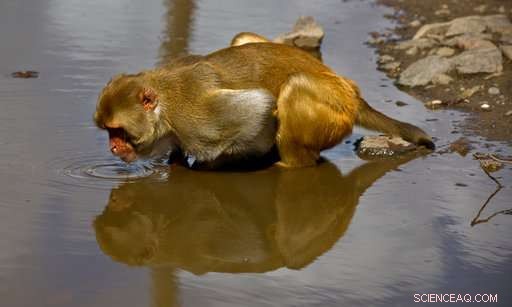
In this Wednesday, Oct. 4, foto 2017, a monkey drinks from a puddle on Cayo Santiago, known as Monkey Island, in Puerto Rico, one of the world's most important sites for research into how primates think, socialize and evolve. Researchers have been spending much of the year on the island studying everything from the monkeys' eye movements to the genes and behavior of socially aberrant individuals that may provide insight into the causes of autism. (AP Photo/Ramon Espinosa)
Mainland scientists are bringing in equipment from chain saws to a portable pier, funded by tens of thousands of dollars raised so far in university departments and online.
Complicating the effort, the monkeys all carry herpes B, a version of the virus that is harmless to macaques but can be fatal in humans. Anyone who comes into contact with monkey saliva or urine must undergo rigorous decontamination and treatment with antiretroviral drugs.
Humans also pose risks for the monkeys. Because the hurricane destroyed the island's chemical toilet, researchers and workers can stay only until they need a bathroom break:Human waste could start an epidemic that could wipe out the monkeys.
While the rescue effort is heroic, "it's not sustainable, " said Higham, who is bringing in a container full of supplies, possibly on a ship that would anchor off the island. "They're doing the best they can do under very difficult conditions, but it needs help and attention."
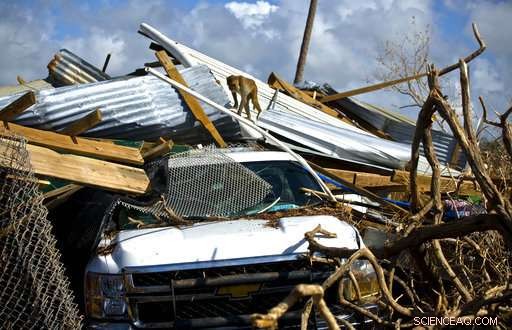
In this Wednesday, Oct. 4, foto 2017, a monkey walks over the rubble left in the wake of Hurricane Maria on Cayo Santiago, known as Monkey Island, in Puerto Rico, one of the world's most important sites for research into how primates think, socialize and evolve. The storm destroyed virtually everything on the island, stripping it of vegetation, wrecking the monkeys' metal drinking troughs and crushing the piers that University of Puerto Rico workers use to bring in bags of monkey chow, brown pellets of processed food that complete the primates' natural vegetation diet. (AP Photo/Ramon Espinosa)
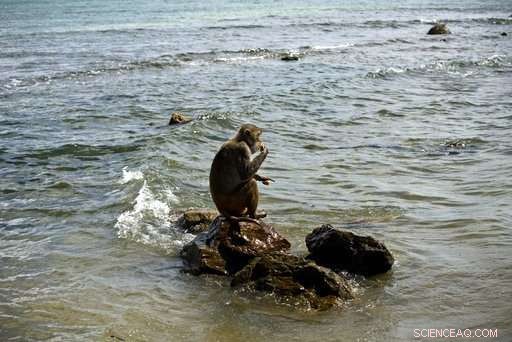
In this Wednesday, Oct. 4, foto 2017, a monkey eats atop a rock off of Cayo Santiago, known as Monkey Island, in Puerto Rico, one of the world's most important sites for research into how primates think, socialize and evolve. The island's history as a research center dates to 1938, when the man known as the father of American primate science brought a population of Indian rhesus macaques to the United States. (AP Photo/Ramon Espinosa)
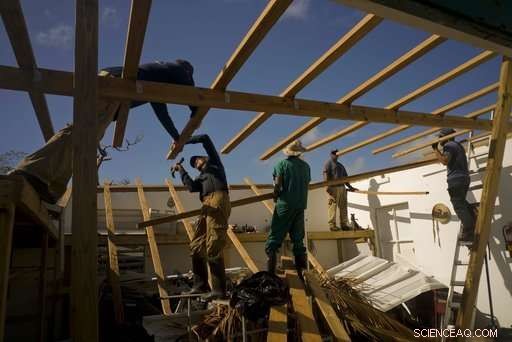
In this Wednesday, Oct. 4, foto 2017, workers repair research facilities destroyed by Hurricane Maria in Cayo Santiago, known as Monkey Island, in Puerto Rico, one of the world's most important sites for research into how primates think, socialize and evolve. Mainland scientists are bringing in equipment from chain saws to a portable pier, funded by tens of thousands of dollars raised so far in university departments and online. (AP Photo/Ramon Espinosa)
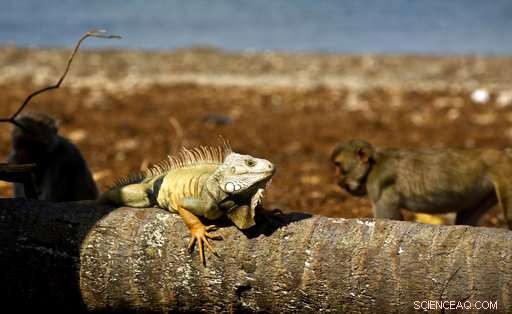
In this Wednesday, Oct. 4, foto 2017, an iguana sunbathes as monkeys walk behind on Cayo Santiago, known as Monkey Island, in Puerto Rico, one of the world's most important sites for research into how primates think, socialize and evolve. In 1938, man known as the father of American primate science, Clarence Ray Carpenter, wanted a place with the perfect mix of isolation and free range, where the monkeys could be studied living much as they do in nature without the difficulties of tracking them through the wild. (AP Photo/Ramon Espinosa)
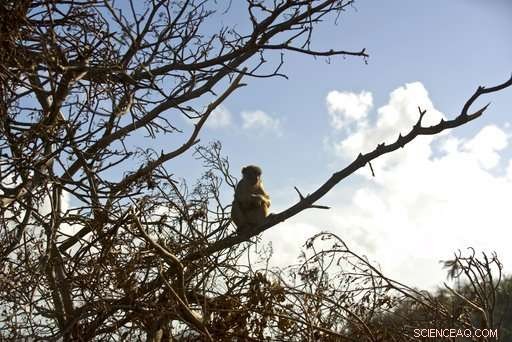
In this Wednesday, Oct. 4, foto 2017, a monkey rests on a tree branch on Cayo Santiago, known as Monkey Island, in Puerto Rico, one of the world's most important sites for research into how primates think, socialize and evolve. Since 1938, the 400 or so macaques have reproduced and expanded their numbers, becoming the world's most studied free-ranging primate population and something of a living library. (AP Photo/Ramon Espinosa)
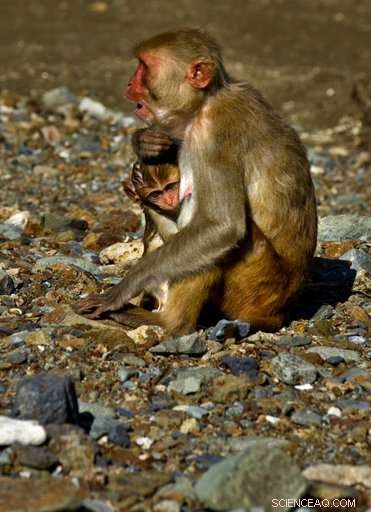
In this Wednesday, Oct. 4, foto 2017, a female monkey holds her baby on Cayo Santiago, known as Monkey Island, in Puerto Rico, one of the world's most important sites for research into how primates think, socialize and evolve. Every animal born on the island is tattooed for easy identification, and the skeleton of every one that has died over nine generations has been saved for future reference. (AP Photo/Ramon Espinosa)
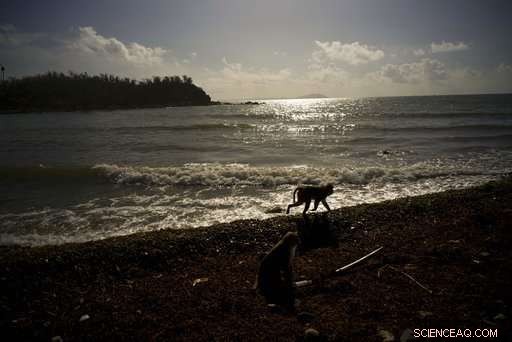
In this Wednesday, Oct. 4, foto 2017, a monkey walks along the shore of Cayo Santiago, known as Monkey Island, in Puerto Rico, one of the world's most important sites for research into how primates think, socialize and evolve. About 100 macaque monkeys here have had their entire genetic makeup sequenced, and hundreds more have had at least some of their DNA analyzed. (AP Photo/Ramon Espinosa)
© 2017 The Associated Press. Tutti i diritti riservati.